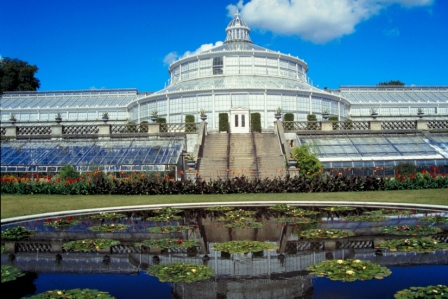
A greenhouse is a structure made of transparent or translucent materials such as glass or polycarbonate to let in sunlight and warm the air inside. Greenhouses can be temporary or permanent structures, and they can vary in size from those as large as football fields to ones that are small enough to sit on a tabletop. They work on the basic principle that incoming sunlight warms the air and objects inside the greenhouse, and the glass then traps the warm air, preventing it from escaping.
The Romans are commonly credited with inception of the greenhouse. As early as 30 A.D., they had the idea to grow plants in climate controlled environments. At that time, glass was not available, so the Romans used extremely thin sheets of mica, a translucent type of rock material. It is said that the Roman emperor, Tiberius, took a liking to a certain type of vegetable, similar to a cucumber, so much so that he wanted to eat one every day. It is for this reason that the Romans devised the first greenhouses, so they could satisfy the emperor’s desire for the vegetable every day of the year.
In the 13th century, Italians began building more modern versions of greenhouses. They did so in order to cultivate the tropical plants that explorers of that time brought back from overseas. Over the next few centuries, the idea of the greenhouse, as well as many of the tropical plants that the Italians were growing in them, would spread across Europe. These early greenhouses were still not very well designed, and the gardeners who tended them had many problems with temperature control.
A French botanist named Jules Charles is typically credited with building the first modern and practical greenhouse in the city of Leiden in The Netherlands. This greenhouse was erected in 1599 for the purpose of growing medicinal plants, but Charles’ fellow Frenchmen quickly adapted his new greenhouse model for other purposes. The French were known for their love of new fruits, and they were soon building their own greenhouses to grow the tropical fruits they desired. Greenhouses for growing oranges, called orangeries, and greenhouses for growing pineapples, called pineries, were quite common in France.
The Europeans continued to experiment and refine their methods of building greenhouses during the 17th and 18th centuries. Better glass and improved building technology enabled Europeans to build larger and more beautiful greenhouses, and many such structures were built to please the aristocracy. The Palace of Versailles is one such example. An extremely large and elaborate greenhouse was built on the grounds of the palace to grow oranges for French royalty. Victorian greenhouses similar to this one sprung up in vast numbers across Europe during the 18th and 19th centuries.
The first American greenhouse was built in Boston in 1737 by a rich merchant of the time, a Mr. Andrew Faneuil. The concept caught on quickly in the U.S., and by the 19th century, greenhouses were quite common. George Washington had a greenhouse built at Mt. Vernon so he could grow pineapples, a fruit he was quite fond of and wished to serve to his many dinner guests.
Today greenhouses are used all over the world for growing plants and flowers. Many large commercial faming operations rely on greenhouses for growing produce. Small greenhouses used by families are common as well, and greenhouse kits and supplies can be easily purchased online.
Ellen Bell works for a retail website that offers greenhouses and related products.
Related Articles & Free Email Newsletter
Inexpensive Tools and Materials Every Small Greenhouse Grower Should Have




Comment here